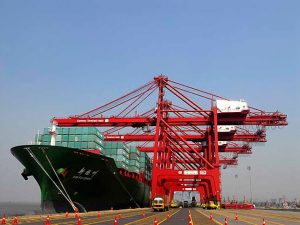By Sudha Ramachandran
On August 10, India’s Prime Minister Narendra Modi unveiled plans for the development of a transshipment terminal at Great Nicobar island, one of the Andaman and Nicobar Islands (ANI). Part of a slew of projects that India is implementing in the archipelago to boost economic development there, the transshipment port project, estimated to cost 100 billion Indian rupees, could also help India address some of the problems dogging its maritime trade.
The ANI is a chain of 572 islands, of which 325 belong to the Andaman group and 247 to the Nicobar group. The archipelago lies east of the Indian mainland in the Bay of Bengal. In terms of distance, the island chain is closer to several Southeast Asian countries than to mainland India. While Port Blair, the ANI’s capital, is 750 nautical miles from the Indian mainland, the archipelago’s northernmost island is just 22 nautical miles from Myanmar and the southernmost tip only 90 nautical miles from Indonesia. Thailand lies 270 nautical miles to the east of the ANI.
A port at Great Nicobar will therefore provide a shot in the arm to India’s trade with Southeast Asia and a much-needed boost to its “Act East” policy.
The ANI lies close to important sea lanes of communication. The Great Channel, where three major Indian Ocean shipping routes converge and which leads into the Strait of Malacca — a strategic waterway through which 90 percent of crude oil shipped through the South China Sea transits — lies to the south of Great Nicobar Island.
The proposed transshipment terminal is being built at Campbell Bay at Great Nicobar, the largest of the Nicobar group of islands. Incidentally, Campbell Bay also hosts the Indian Naval Station (INS) Baaz, which falls under the tri-services Andaman and Nicobar Command of the Indian military.
It is only over the last couple of decades that the Indian government has begun infrastructure development in the ANI. Efforts to improve air, sea, and overland connectivity between the islands and with the Indian mainland have gathered momentum only in recent years. In August, a submarine optical fiber connectivity project was inaugurated. Alongside, an array of projects to boost the ANI’s tourism and trade are also being implemented. The transshipment terminal at Great Nicobar is part of this effort to boost the islands’ economic development.
The Great Nicobar port project will provide employment opportunities to locals. But more important is its value to India as a transshipment terminal.
The shipping business in India has suffered on account of India’s poor port infrastructure. Most Indian ports have shallow drafts, which means that ships with higher tonnage — which is increasingly the norm in international maritime trade today — cannot dock at these ports. Consequently, large container ships with cargo headed for India must offload at nearby transshipment ports where their freight is then loaded on to smaller feeder vessels that can dock at Indian ports. Shippers must pay port handling charges at transshipment ports, which add to their costs.
Almost a quarter of India’s maritime trade is shipped through ports in other countries and over 80 percent of its transshipment cargo uses facilities at ports in Singapore, Colombo in Sri Lanka, and Klang in Malaysia.
Transshipment costs are leading to Indian port industry losses of Rs 15 billion annually. This translates into an “estimated loss of Rs 3,000-4,500 crore [Rs 30-45 billion] to the economy based on the economic multiplier effect of 2-3 times for ports on country’s economy.”
The need to improve overall cost of shipping has prompted India to improve its port infrastructure, including the development of container transshipment terminals. Such terminals have been constructed at Vallarpadam in Kochi and Vizhinjam near Tiruvananthapuram, both on Kerala’s coast. There are plans to build another transshipment port at Enayam in Kanyakumari, the southern tip of India.
The proposed Great Nicobar transshipment terminal will add to this capacity.
Campbell Bay has a draft of 20 meters, which means that large container vessels of over 15,000 Twenty-foot Equivalent Units (TEU) can dock there.
Not only will the Great Nicobar terminal provide Indian shippers with another alternative to foreign transshipment ports but will also help India’s shipping and port industry eye a share in the global transshipment business. It will hope to draw the business of countries currently using other regional transshipment facilities such as Bangladesh and Myanmar, which are using facilities at Singapore. These countries could shift to transshipping via Nicobar.
While the fact that Campbell Bay is just eight nautical miles from the East-West shipping route and situated outside the crowded Strait of Malacca makes the Great Nicobar transshipment terminal an attractive option for shippers, the path ahead may not be easy.
Port Blair has not been able to attract shipping traffic. Will the Great Nicobar Port succeed where Port Blair failed? Transshipment ports at Vallarpadam and Vizhinjam have not been able to draw business away from the Colombo port, which handles 43 percent of India’s transshipment freight. Industry experts say that charges at Indian transshipment ports are far higher than those at Colombo, and bureaucratic procedures at the latter are far smoother. Consequently, terminals at Vallarpadam and Vizhinjam are functioning below capacity.
Terminals at Vallarpadam and Vizhinjam are finding it tough to survive. Will the experience of the Nicobar transshipment terminal be different?
Given their proximity to each other, Vallarpadam and Vizhinjam are competing for the same market and cutting into each other’s business. While the Nicobar terminal will be eyeing cargo heading for Colombo’s transshipment facilities, it also could attract export-import businesses in the Bay of Bengal littorals and the East-West shipping route.
But first, it must draw lessons from the mistakes made by port authorities at Vallarpadam and Vizhinjam. India will need to implement reforms of its cabotage law if it is serious about its dreams of emerging as a global or even regional transshipment hub.

No comments:
Post a Comment